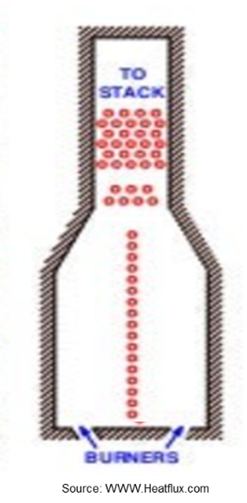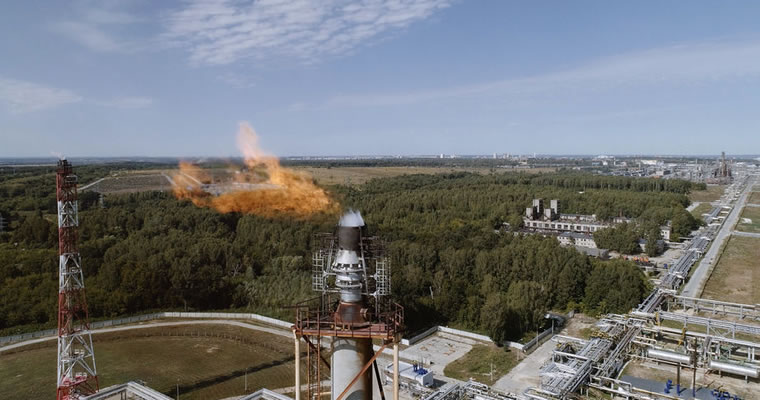Prevention of Tube Rupture – Reactor Feed Furnaces
Consider the intrinsic risks of a reactor feed furnace in a hydrotreater or hydrocracker:
- On the outside of the furnace tube, we have intense fire from the burners
- On the inside of the furnace tube, we have high-pressure H2 or a H2/oil mix where the oil is above its autoignition temperature, and the vapor contains percent levels of H2S
We are completely dependent on the integrity of the metal tube to prevent a leak or tube rupture with subsequent fire and potential detonation. Tube leaks or ruptures will release substantial amounts of oil, H2, H2S, and NH3 and present a significant process safety risk.
Of course, there are also safety concerns on the firebox side of the furnace, but this blog entry will focus on the process side of the furnace.
Tube Rupture Incidents
Incident 1
In 1998, a hydrocracker feed furnace at the Irving St John Refinery suffered an explosion on the reactor feed furnace that resulted in a fatality. During normal operation, the inside control operator noticed the furnace excess oxygen reading was falling and the furnace stack was reported to be smoking. An operator was sent out to the furnace to investigate. While the operator was working around the furnace, a tube ruptured releasing high-pressure H2 and oil into the fire box. The fire box was breached by the force of the explosion and the operator was killed. The report for this incident can be found at this link: Accident Investigation Report on the Explosion and Fire at the Irving Oil Refinery, Saint John, New Brunswick (petroblog.com.br).
This type of incident can happen and has happened in hydrotreaters as well.
Tube ruptures in high-pressure furnaces (above 1,500 psig) can cause explosions that extend out of the firebox as happened in the above incident. The tube ruptured due to hot spots that developed from a combination of coking inside the tube and flame impingement on the outside of the tube. Even tube ruptures on units that operate below 1,500 psig can be extremely hazardous with substantial personnel and process safety risks.
Incident 2
Operators were working to startup a reactor feed furnace with 4 passes on a hydrocracking unit. One of the passes showed high skin temperatures compared to the other passes and operators were concerned that this pass was stalled (no flow). Operators continued to work on getting flow through the stalled pass when suddenly a tube ruptured on the stalled pass resulting in a detonation that killed 8 people.
Lack of flow on any furnace pass should cause the furnace firing to be shut down until flow can be established.
Prevention of Tube Rupture
Measures for preventing tube rupture on reactor feed furnaces include the following items:
- Furnace Safety Systems
Reactor feed furnaces should have safety interlock systems (SIS) to detect abnormal operation and shutdown the furnace before a tube leak or rupture occurs. An example of a successful SIS on a reactor feed furnace is:
- Loss of oil flow OR hydrogen gas flow cuts the furnace to minimum fires or pilots
- High furnace outlet temperature chops the furnace fires completely
- Loss of oil flow AND hydrogen gas flow chops the furnace fires completely
The principle behind the SIS trips is: No flow = No Fire (and low flow = low fire. There are other variations that have been used successfully.
The SIS system for the furnace should be determined using a HAZOP/LOPA process: see “Layers of Protection Analysis” published by the Center for Chemical Process Safety (CCPS). Safety Instrumented Systems (SIS) should be designed to adequately mitigate the risks identified by the HAZOP/LOPA using Industry Standards to make sure adequate and appropriate layers of protection are achieved. See IEC 61508 and IEC 61511.
- Furnace skin temperature measurement
Every furnace should have adequate functioning skin temperature measurements. The skin temperatures should have alarms and limits based on the furnace operation and tube metallurgy. Non-functioning skin TIs should be replaced as necessary to maintain adequate tube measurement.
- Operations burner management
Furnace operation should include regular monitoring and adjustment of burner operation to prevent flame impingement on the tubes. Most furnaces require periodic burner cleaning, which should be completed as often as it becomes necessary.
- Furnace Process Monitoring
Furnace efficiency (Absorbed duty/Fired duty) should be monitored to help determine when fouling or coke deposits may be occurring. An increase in tube pressure drop may also indicate the presence of fouling.
Monitoring of combustion box oxygen levels may indicate changes in fuel quality or combustion behavior that requires operational adjustments or burner management.
- Regular Infrared Scans
A newer tool in our arsenal is regular infrared furnace scans by qualified personnel. Many refineries have purchased infrared cameras and trained personnel on how to operate them. Infrared measurements can detect hot spots and coking over time. They can also be used to calibrate and prove the operation of skin TI’s and to scan furnace skins to check refractory integrity.
The frequency of furnace infrared scans can be determined by history or by the monitoring variables discussed above, but many refiners have found that a quarterly scan can be very useful. Some difficult furnaces may require more frequent scans.
Infrared scans have also proven useful for many other applications in hydroprocessing units. Scans of reactor effluent coolers have shown plugged tubes and maldistribution of flow or wash water. Scans of wash water injection points have found partially or fully plugged injection nozzles or even uneven flow in multiple wash water injection points.

- Conservative furnace design with correct tube metallurgy
Reactor feed furnaces should be designed in a conservative manner:
- Many furnaces are designed to be double fired with conservative heat flux to minimize the potential for coking and hot spot creation.
- Box style furnaces with horizontal tubes are preferred to make the furnace free draining.
- Horizontal tubes are easier to maintain two-phase flow because they don’t “liquid-lock” like vertical furnace tubes.
- Furnace tubes should be designed to promote a dispersed two-phase flow regime to help prevent fouling and coking.
- Tube metallurgy should be determined to avoid high-temperature hydrogen attack (HTHA), sulfidation, tube creep, and other corrosion/damage mechanisms.

- Proper inspection and maintenance during outages
Tubes should be inspected for corrosion and creep during outages. Furnace tubes should be cleaned, when necessary, by pigging (preferred) or by decoking.
Single Phase vs. Two-Phase
The guidelines and advice in this document apply to both single-phase and two-phase furnaces, although gas-only furnaces can easily use vertical tube designs.
Application in your unit(s)
- Does your reactor feed furnace have a safety interlock system (SIS) to shut down the furnace when unsafe conditions are detected?
- Does your furnace have adequate, functioning tube skin temperature measurement in place?
- Does your refinery have a good burner management process in place so that burners are adjusted when necessary and cleaned when dirty?
- Does your refinery have regular infrared scans of the furnace tubes done by experienced personnel?
- Does your refinery have a heater performance monitoring program in place to get early indication of any coking/fouling that may be occurring?
- Are your personnel trained on the hazards of furnace operation and correct procedures?
As always, I welcome and appreciate feedback, questions, comments, and suggestions on this topic and other topics covered in my blog.




